Managing Project Communications
Communications form an essential part of any project and unlike technical areas, for example estimating and risk assessment; communication is something that the project manager has to take direct personal responsibility for. The lack of a communication plan is often the biggest single mistake the project manager can make because completing a complex project successfully requires teamwork, and teamwork requires good communication.
Managing communications within the project includes all of the processes required to ensure timely and appropriate generation, collection, storage and distribution of project information. The aim is to create a communication infrastructure so that everyone involved has access to the right information at the right time.
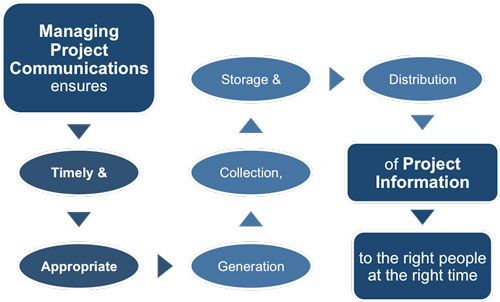 |
Communication is usually thought of as a general management skill rather than one that is specific to project management. Whilst this is true, there are some features of projects that can cause communication problems and make a communication plan both desirable and necessary.
Projects can create a huge volume of data that needs to be collected, collated and analyzed. The findings of these tasks must then be disseminated appropriately to each individual connected with the project so that they can perform their role and move the project closer to the end product. Without careful thought put into how, what and when such data is distributed to other project members' communications will create confusion and chaos resulting in frustration and poor productivity.
Poor planning frequently results in people being 'over communicated' with especially as emails, texts, electronic documents are too easy to quickly copy to 'everyone' and avoid having to sufficient time to think about who really needs to have the information it contains.
This creates its own problems and can severely damage the productivity of the project team because recipients:
Get so much they don't know what is pertinent and needed.
They scan to get a feel for its content rather than read it properly.
Key data is missed because it is lost amongst so much information.
Messages aren't clear so errors occur through poor understanding.
Conflict arises from different groups interpreting the data differently.
It is important to avoid these pitfalls and project managers can achieve this by carefully assessing who needs to know what and then planning when and how this will happen. There are many groups of people that need to be communicated with and each requires different levels of information and frequency.
As the diagram below shows they fall into two general types; those needing high-level strategic information and those needing low-level functional information. By planning the communications with each type a project manager is able to set expectations appropriately
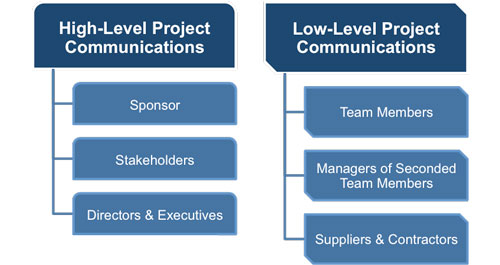 |
The communications management plan defines the format, content (including language, level of technicality), level of detail for each communication and to whom it is circulated to. It describes the purpose for the communication as well as the individual responsible for writing and sending it at a stated period in time or project phase. This plan also has a glossary of the terms that will be used in project communications to avoid confusion. Finally, it states the resources that will be allocated to this functional area of project communications.
There is one group of individuals that play a major role in any project and as such require their own management plan and those are the project stakeholders. The importance of communications between them cannot be overstated. The level, content and frequency of such communications form the bedrock of a projects success.
As part of the project initiation and planning phases it is critical to identify all of the organizations and people who may have an impact on the project, and all those who may be impacted by it. A 'stakeholder' is any person or organization that is actively involved in a project, or whose interests may be affected positively or negatively by execution of a project.
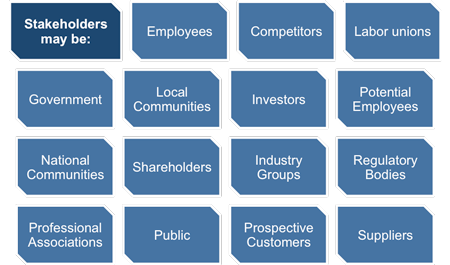 |
A project manager must be sure to identify and list all potential stakeholders for a project. In addition to those on the project team potential stakeholders include a varied selection of people and groups as shown in the diagram below.
Stakeholders can be internal to the organization or external. In many projects the public at large will become a stakeholder to be considered during the project. The challenge for the project manager when the public is a stakeholder will be to act while considering public needs. Often there is no direct representative of the public to be consulted during project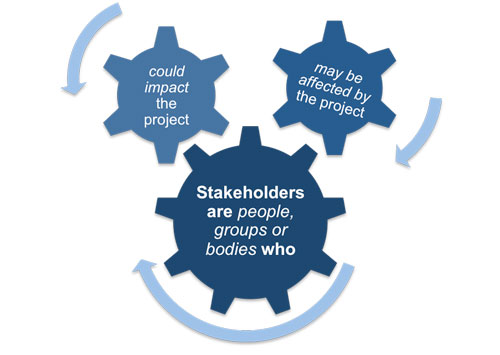 |
A project manager's job consists of making decisions and then communicating these to the appropriate stakeholders in a timely and efficient manner. In order to make these decisions the project manager is dependent on the effective flow of information from and between the stakeholders.
All stakeholders, even those only involved only at the periphery of the project, need to be kept informed of the project aims, its progress and any changes that may affect them. In addition to merely informing them, the project manager should actively manage the way that this information is disseminated in a way that reassures people and keeps them onside.
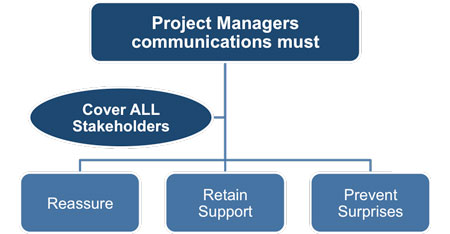 |
If this is not done in a systematic way, stakeholders may see or hear something regarding the project and draw their own erroneous conclusions about how it will negatively affect them. This can result in political problems that could have been averted if the project manager had kept everyone informed and reassured.
The stakeholder management plan defines the processes a project manager will use to identify the people, groups, or organizations that could impact or be impacted by their project. Identifying the stakeholders' needs to be done very early in the project because the cost of making changes increases as the project progresses. It is important to identify and engage the stakeholders' as early as possible so their requirements can be fully understood from the outset.
Stakeholder management also focuses on continuous communication with stakeholders to understand their needs and expectations, addressing issues as they occur, managing conflicting interests and fostering appropriate stakeholder engagement in project decisions and activities. Their satisfaction should be managed as a key project objective.
Stakeholder involvement should be supported by:
• An emphasis on quality relationships in which the parties:
o Are aware of their responsibilities
o Where communication between them is clear and comprehensive.
Stakeholder-based contributions to project success include executive support and effective use of the organization's infrastructure to support the project.
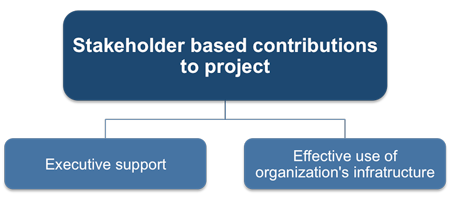 |
A project manager must document relevant information for all identified stakeholders. This information may include the stakeholder's interests, involvement, expectations, importance, influence, and impact on the project's execution as well as any specific communications requirements. It is important to note that although some identified stakeholders may not actually require any communications they should still be identified.
One of the key objectives of any project must be managing and maintaining stakeholder satisfaction. This management is a continual process of communication between the project manager and the stakeholders, in order to:
• Understand their needs and expectations
• Address issues as they occur
• Manage conflicting interests
• Foster their engagement in project decisions & activities.
Stakeholder management includes the processes required to manage all of the parties with an interest in the project. Stakeholder identification and management is a key skill for all project managers. Stakeholders are individuals who represent specific interest groups served by the outcomes and performance of a project or program.
Project managers must give due consideration to the people issues surrounding projects and recognize that the appropriate involvement and management of stakeholders is almost always a critical success factor.
By successfully managing your stakeholders, you will be better able to keep a lid on scope creep, ensure project requirements are aligned, understand tolerance for risk, and mitigate issues that would otherwise delay the project. Good stakeholder management is a testimony to your influence in an organization, and a key component to a healthy project environment.
This whole area of project HR management (including the sub plans for communications and stakeholder management) is important because it helps an organization to achieve its strategic objectives by creating a positive relationship with everyone involved through effective management of their expectations.
You may also be interested in:
Managing a Project Team | Developing the Project HR Plan | Building an Effective Project Team | Developing the Project Team | Dealing with Conflict in the Project Team | Planning Project Communications | Optimizing Project Communications | Managing Project Communications | Identifying Project Stakeholders | Keeping Project Stakeholders Informed.
|
|


